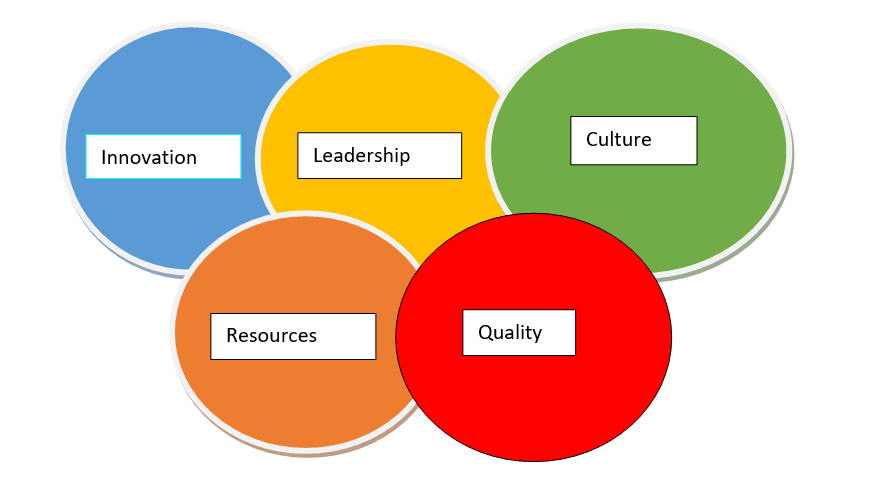This article will discuss internal factors affecting the business organization.
As businesses aim to satisfy customers and outpace their competitors, innovation and strong leadership become distinguishing features. Quality, culture, and resources also play crucial roles in driving growth and ensuring sustainability. And in today’s ever-evolving landscape, adaptability to change can make or break a business.
While these internal factors hold immense power over an organization’s success, the business can shape and influence them. By staying vigilant and leveraging these factors, businesses can gain a competitive edge and thrive in today’s dynamic marketplace.
So let’s dive in and discover how to make the most of these internal factors and build a successful business organization.
Internal Factors Affecting the Business

The success of an organization is subject to various internal and external factors. External factors are those beyond the control of the business, such as economic conditions, regulatory changes, and emerging technologies. While these factors present opportunities or threats, organizations cannot directly influence them.
On the other hand, internal factors such as company culture, leadership, resources, and operational processes are well within the organization’s control. These internal factors can either be positive, such as strengths that can be leveraged, or negative, such as weaknesses that must be addressed. Since they are internal, organizations have the power to control and improve them, leading to enhanced business sustainability.
A few examples of internal factors are:
- Innovation
- Leadership
- Quality
- Organizational culture
- Resources

Innovation
In today’s fiercely competitive market, businesses aim to capture new audiences and fulfill unmet consumer needs through innovative products and services. Innovation is the key to staying ahead of the game and must be driven from within an organization.
Generating innovative ideas is not limited to the top brass of a company but can come from anyone, including shop floor workers or management. However, change often faces resistance, and companies may shy away from taking risks that could lead to leading the market and trailblazing.
To succeed, businesses must explore new ways to meet evolving consumer needs, reduce operational costs and waste, and add value. Achieving this requires a significant investment in market research, internal capabilities, and cultural change.
Innovation can be costly in terms of time, money, and cultural shifts, but the payoff is worth it in the long run. A prime example is Saudi Aramco, which invested heavily in research and hired numerous specialists and scientists in 2012. By 2022, the company had secured 966 patents, demonstrating the significant impact that innovation can have on a business’s success.
Leadership
Effective leadership is the cornerstone of any successful organization. It provides direction and clarity on the company’s vision, distinguishing it from its competitors. While management focuses on optimizing resources, leadership looks ahead, setting goals and inspiring followers to achieve the organization’s objectives.
One of the most prominent examples of great leadership is Jack Welch, who transformed General Electric (GE) from a company known for appliances and light bulbs to a multinational conglomerate, earning himself Fortune magazine’s coveted title of “Manager of the Century.” Under his guidance, GE’s revenue skyrocketed from 26.8 billion USD in 1981 to 130 billion USD in 2001.
Great leaders create a thriving company culture where employees feel valued and inspired. They have a clear view of the company’s strengths and weaknesses and care about their employees, placing the right people in the right roles. They manage people’s expectations and communicate their vision for the company’s future. Leaders influence culture and values, effect change, and motivate employees. They promote honesty, hard work, and punctuality, rewarding excellence and leading by example.
In essence, effective leadership provides the necessary guidance, vision, and culture to empower employees to achieve their best work and drive the organization’s success.
Quality
Leadership is about inspiring and guiding employees to achieve the organization’s goals, while quality is about meeting customer expectations. Ensuring the highest quality standards is essential, as poor quality can significantly impact an organization’s market share.
While quality is critical in all industries, it’s especially vital in the service sector, where customers can’t return products but can easily discontinue service subscriptions, directly affecting sales. Toyota, for example, is a prime example of a company that delivers better products and gains customer loyalty by utilizing quality management tools such as Total Quality Management (TQM), kaizen, and Six Sigma. They collect user feedback and continually improve their products based on this feedback.
In the 1980s, Japanese companies implemented TQM to develop electric circuit boards, which significantly increased the first-pass yield by almost 100%. American companies subsequently adopted this approach by embracing the power of measurement.
In TQM, measurement is critical, and indices such as rework, scraps, waste, yields, and process part-per-million defect rates must be measured for quality control. This applies equally to service companies, which must adopt feedback on customer satisfaction, retention rate, responsiveness, and cost.
The American delegates learned to measure rework through adopting TQM, discovering their first-pass yield was just 16%. Within six months, they had successfully adopted TQM, raising their first-pass rate to 60%.
In essence, organizations that embrace the power of measurement can significantly improve their processes and efficiency, ultimately leading to higher quality standards and greater customer satisfaction.
Culture
The cultural factor within an organization is driven from the top down and evolves gradually over time. Business culture encompasses established norms, traditions, beliefs, ethics, values, attitudes, and practices that drive and shape an organization’s operations. It is deeply ingrained in the business and can be challenging to change without sustained effort from top management.
A company’s culture portrays its identity and impacts every aspect of its operations, from how employees interact with each other to how they serve customers. A positive culture can inspire employees, promote collaboration, and increase productivity, while a negative culture can lead to employee disengagement, high turnover rates, and a damaged reputation.
To foster a positive culture, top management must lead by example and embody the values they wish to promote. They must communicate the company’s vision and values to employees and reinforce these values through recognition and rewards. Cultural change is a gradual process that requires ongoing effort, but the payoff is well worth it in the long run.
Resources
Resources are a vital component of any organization; they can be physical or human. Physical resources include assets, infrastructure, and tangible objects like work tools. The availability of physical resources is crucial in boosting productivity, and tools can significantly increase personnel capabilities.
Capabilities can be core or distinctive, and core capabilities give a company a competitive edge. By developing and utilizing core capabilities, businesses can differentiate themselves in the marketplace and excel in their respective industries.
However, the greatest asset of any organization is its people. Human resources encompass employees, their skills, networks, and associations that help the organization turn inputs into outputs. Hiring and retaining the best talents and providing them with an environment to thrive is essential for effective leadership.
Organizations can enhance productivity and drive long-term success by investing in human resources and developing their skills. Creating a culture that values and nurtures its people can inspire employees and foster a sense of loyalty, leading to increased productivity and positive business outcomes.
Internal Factors in SWOT Analysis
SWOT analysis is a powerful tool for understanding an organization’s strengths, weaknesses, opportunities, and threats. Strengths and weaknesses are internal, while opportunities and threats are external.
Strengths are the qualities that set a business apart from its competitors. They could be a specific skill in a particular service area or product that makes the organization stand out. Identifying and leveraging these strengths is crucial to achieving a competitive advantage and driving success.
On the other hand, weaknesses are the areas where a business needs improvement. Here, competitors may have an advantage in a particular area, and the organization may lack specific skills, equipment, or processes. To remain competitive, businesses must identify these weaknesses and find ways to fill the gaps, whether by training employees, acquiring new equipment, or improving processes.
By conducting a thorough SWOT analysis, businesses can identify their strengths and weaknesses, capitalize on opportunities, and minimize threats, ultimately leading to long-term success. With a solid understanding of their internal and external factors, organizations can strategically position themselves in the marketplace and achieve their goals.
Conclusion
Internal factors are crucial in shaping an organization’s success, as they are within the company’s circle of control. By continuously reviewing and improving these factors, businesses can exceed stakeholder expectations and achieve sustainable growth.
Fostering a positive culture, investing in human resources, developing core capabilities, promoting innovation, and effective leadership are all key internal factors that can drive success. Organizations can significantly improve productivity, efficiency, and overall success by optimizing these factors and making them a core part of their business strategy.
Businesses must recognize that internal factors may be challenging to change but are vital to long-term success. By embracing a culture of continuous improvement and prioritizing internal factors, businesses can stay ahead of the curve, remain competitive, and exceed stakeholder expectations.
